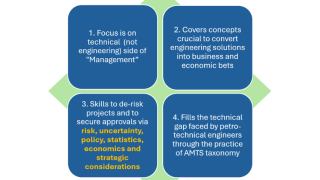Risk management
This paper discusses cases from the North Sea and offshore California in which high-fidelity pressure and dynamics measurements, combined with high-speed telemetry, helped overcome complex geotechnical challenges.
The SPE Asset Management Technical Section (AMTS) is teaming up with the University of Houston to launch a pilot program that advances asset management practices and supports the growth of energy professionals worldwide—setting a model for future collaborations between universities and SPE technical sections.
The SPE Management Technical Section has been officially renamed the Asset Management Technical Section. The new name better reflects the section’s focus on asset management as a core discipline in the upstream oil and gas industry.
-
The influx-management-envelope (IME) concept is an advanced, innovative way to assess influx conditions in managed-pressure-drilling (MPD) operations, offering an improved tool for the decision-making process.
-
Indy Chakrabarti, senior vice president of product management and strategy at Emerson Automation Solutions talks about developments in software solutions for the oil and gas industry.
-
Operators, vendors, academics, and government officials offered an abundance of views and recommendations on cyber-threats to the industry during the American Petroleum Institute’s recent Cybersecurity Conference.
-
At a recent global meeting of operations research and management sciences professionals in Houston, an ExxonMobil research executive stressed the importance of optimization and data analytics to company operations.
-
Safety risks of drilling operations are widespread, with potentially significant consequences. Managing these safety risks is key, and intelligent safety risk software can help.
-
Many of the biggest players in the industry—particularly the majors—have adapted their portfolios for “lower for longer” and are once again sanctioning big projects. While we are not back to the heady days of 2010–2014, we have left behind the dark days of 2015–2016.
-
Sizing a person’s “operating box” for making decisions and taking actions to make room for ingenuity and affordable mistakes provides opportunities for his and the organization’s learning. Which factors affect the resizing of the box and how can the limits be adjusted to encourage continued growth?
-
The average project loses 22% expected net present value at authorization, and only 60% of projects meet all their business objectives once they are completed. Executives can do a lot to increase capital project effectiveness by being committed to the stage-gate process.
-
This paper introduces dynamic risk modeling and reports on a 2016 proof-of-concept demonstration of the emergent capability.
-
Many of the worst oilfield incidents have been attributable to human factors. Consequently, a corporate well-control manual was refreshed to include human factors in the management of well-control incidents.












